Scottish Terrier: description of the breed and the nuances of its content
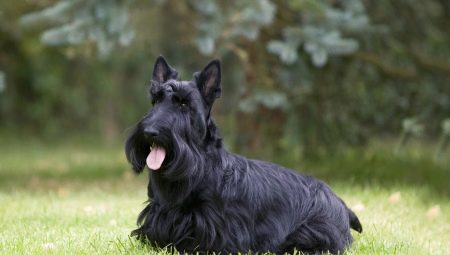
The Scottish Terrier is an aristocratic breed of dog that always attracts attention. Before buying such a pet, you need to familiarize yourself with the description of the breed, according to which it will be possible to choose a purebred puppy and study the nuances of its content. Competent upbringing will help you get an obedient dog that does not cause a lot of trouble.

Origin story
The Scottish Terrier is the oldest Scottish breed of dog. However, although it has existed for quite a long time, it was able to get its portion of popularity only in the mid-80s. At that time, there was a breakthrough in the history of the breed: people refused to cross the short-legged Scottish Terrier with the long-haired Englishman. But the real classification did not work out, therefore, for several decades, all dogs that were used to catch rats or as burrowing dogs were called Scottish Terriers. And in those days, such directions were inherent in the West Highland Terrier, Skye, White and Cairn Terrier.
The process of becoming Scotch tape was hampered by indiscriminate breeding. According to people, in each village at that time there was a vision of the ideal scotch tape, which could be an incredible mixture of genes, combining many different breeds. In 1879, the breed began to be drawn up into a separate category. This was facilitated by the decision of the English Kennel Club, according to which the Scottish Terriers should be placed in different categories, depending on the coat color.
History knows the name of the first breeder, Captain McKee, who played a key role in the process of dividing Scotch tapes into groups.
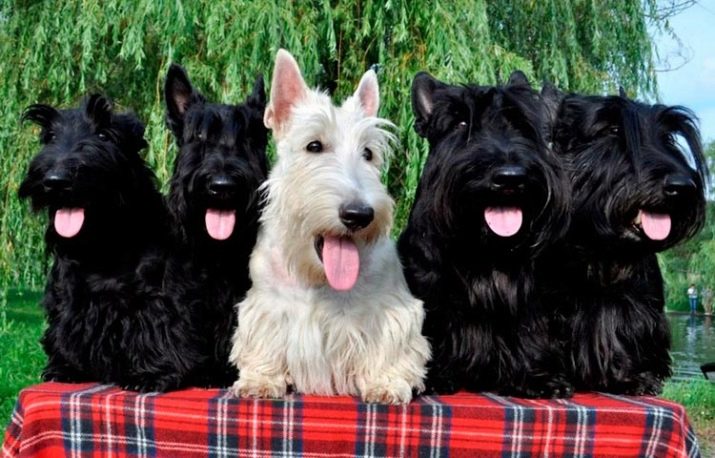
McKee traveled around Scotland in 1880 and bought dogs with wheat and black fur from peasants. Due to his activities, in 1883, the breed developed a breed standard that separated it from the White West Highland and Ash Skye Terrier. On the territory of the United States, the Scotch Terrier appeared in the 19th century, but this breed did not impress anyone. Interest in animals arose after they were acquired by Franklin Roosevelt.
Dogs were brought to Russia in the first half of the 20th century, and they lived with the Rurikovichs. However, after the revolution, the breed was again forgotten, and was remembered only in 1930. At that moment, it did not come to breeding, since the Great Patriotic War began. Pedigree breeding in Russia started in the mid-70s, when representatives of the breed began to be imported from abroad.

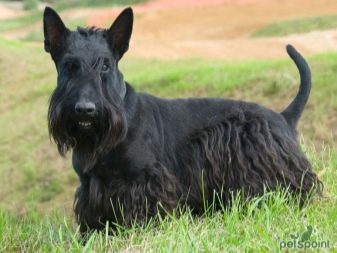
Description
Outwardly, dogs are squat and shaggy animals with a slightly disheveled beard and short limbs. The dog does an excellent job of excavating even hard soil. Since animals belong to the category of small terriers, they are unable to demonstrate large sizes, but are not considered miniature. The characteristics of the breed provide for a height at the withers from 25 to 28 cm, and the weight of the dog can be up to 10.5 kg. The standard states identical figures for bitches and males.
- Head. The skull of a dog has an elongated shape. It should not be too flat, with a small depression from forehead to muzzle at eye level. The head itself is not too wide, it has a square shape. The segment between the outer ears and the outer corner of the eye is of a decent size. The cheeks are straight and flat. The cheekbones do not protrude too much.
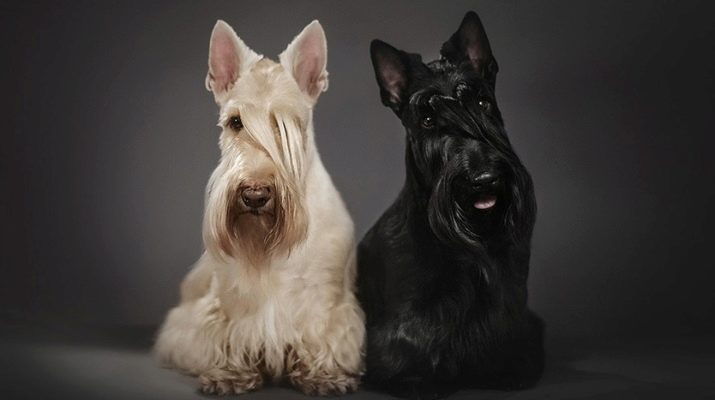
- Jaw. Scissor bite. The jaws have large teeth.
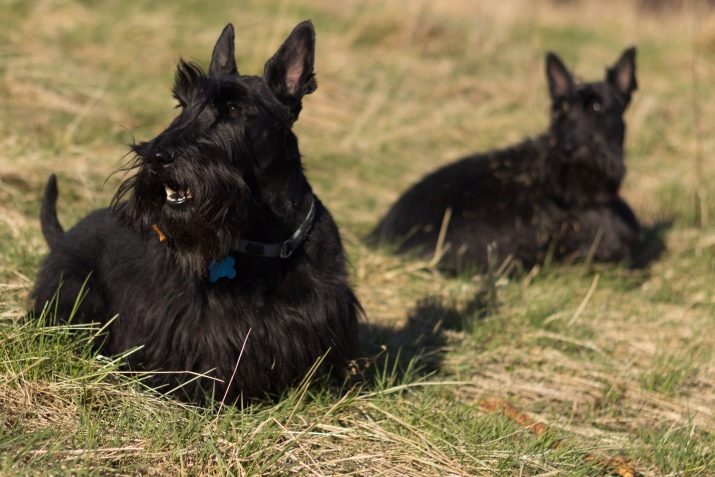
- Nose. The nose is massive, black. The line that runs from the lobe to the chin should be slightly sloped.
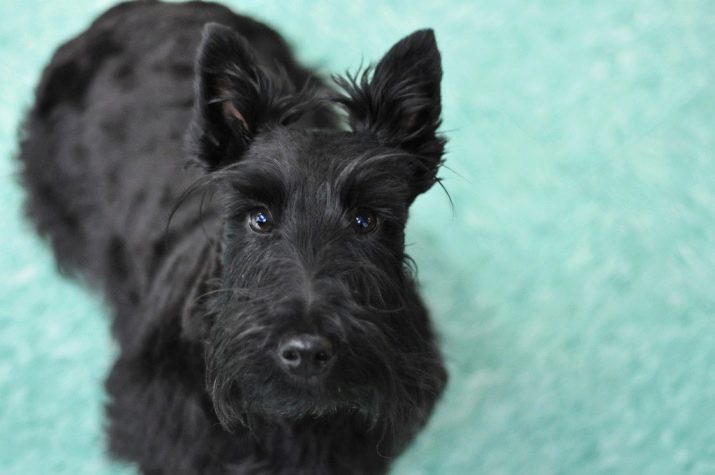
- Eyes. The eyes are dark brown, slightly covered with drooping eyebrows, the landing is wide. The shape of the eyes is almond-shaped. The look of the Scottish Terrier is distinguished by its fervor and insight.
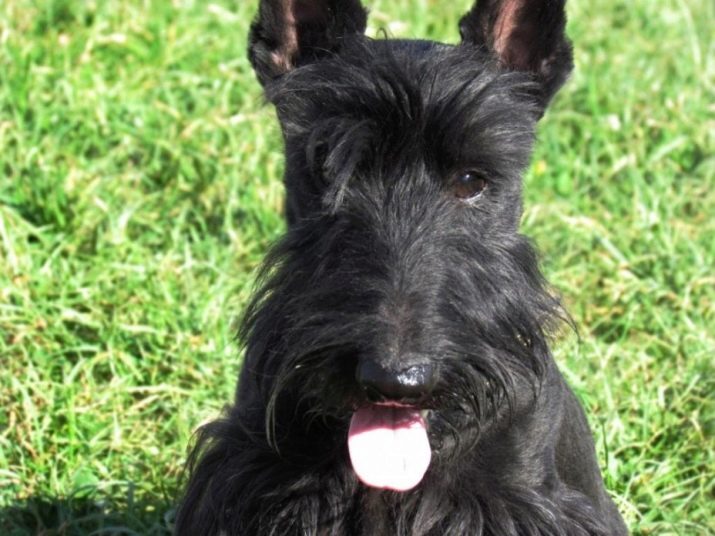
- Ears... This breed is characterized by thin, erect ears, the shape of the ears is pointed.
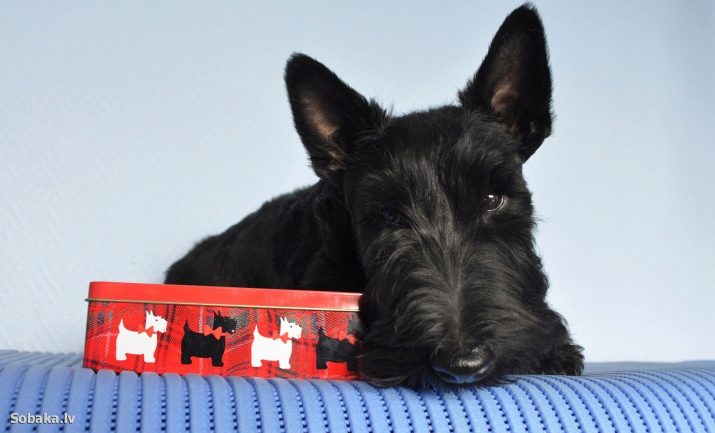
- Neck. The neck is not very long, but rather muscular.
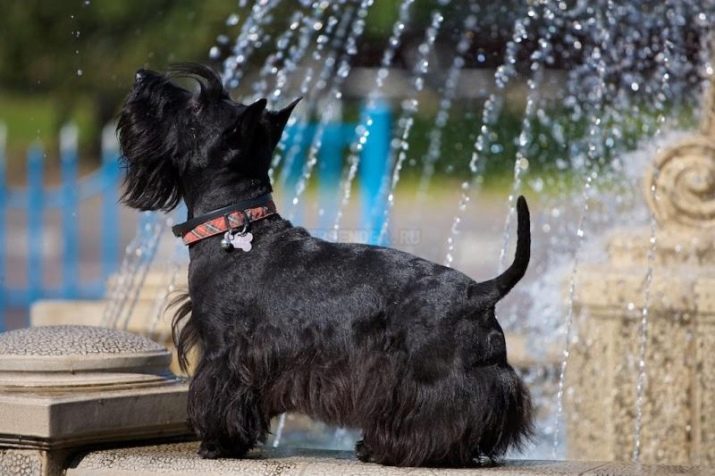
- Torso... The back of the dog is short and should be flat. The topline is almost horizontal. The ribcage is wide, protrudes forward and slopes slightly downward.
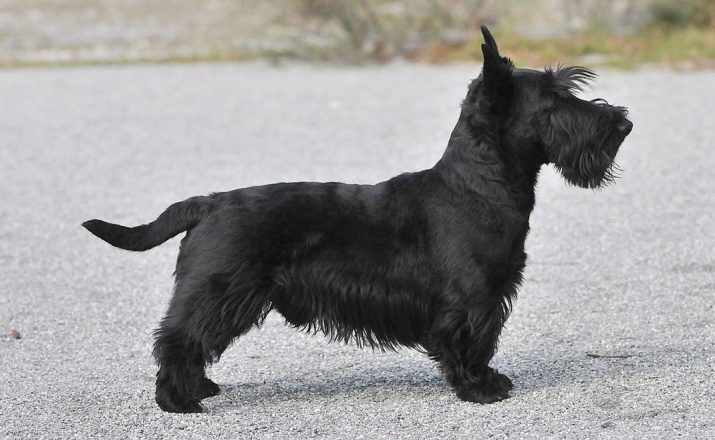
- Limbs... The forelegs are of short length, set parallel. The forearm is bony, the pasterns are even. The hindquarters have large thighs, and the hock joint is strong, despite the fact that it is short in length. The paw is in a ball, the pads are large.
Although the Scotch Terrier has short legs, it is able to cope with a 10 km march or an hour-long excavation. For this breed, such loads are not difficult.
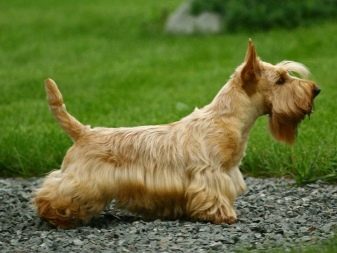
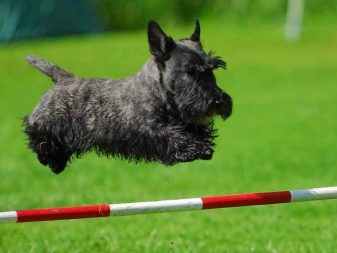
- Tail. The length of the tail is 16-18 cm. The base is thickened, the setting is almost vertical. Slight slope is allowed as standard.
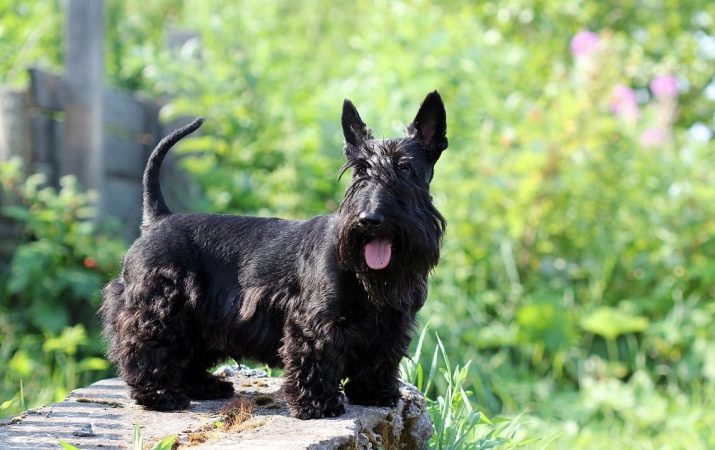
- Wool cover. The coat is formed by a tight-fitting undercoat, a pair of which is a wire-like top coat. The length and density of the coat reach its maximum in the lower half of the animal's body. With the help of such a cover, the dog gets a "skirt" with "pants".
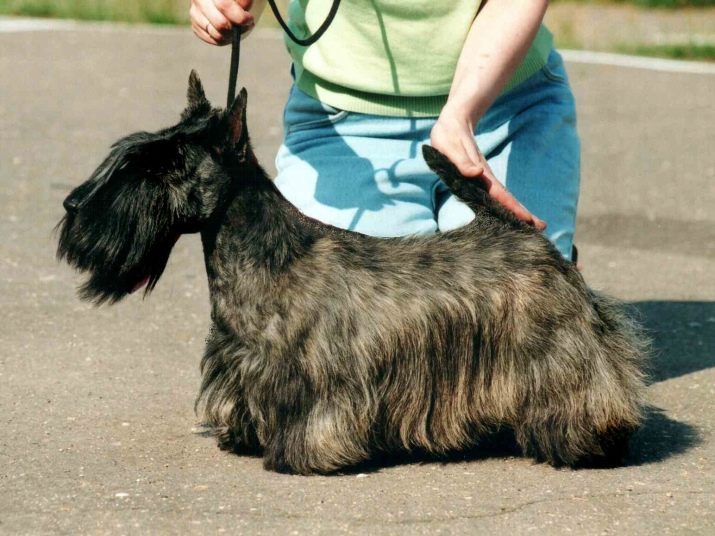
- Allowed colors... The breed standard allows black, brindle and wheat colors. The last two types can exist in any variation. Tiger color can be combined with any shades. Wheat can be light golden, red is also welcome. The white color is currently not popular. If the puppy has such a color, it is not subject to disqualification, but it is not allowed to the shows.
You can exhibit animals with white spots on the chest, the size of which does not exceed a 25-kopeck coin.
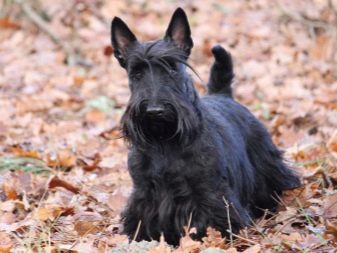

- Vices of the breed. Dogs will be disqualified if deviations from the specified standard are observed or if there are defects in behavior. These features include cowardice, excessive aggression.
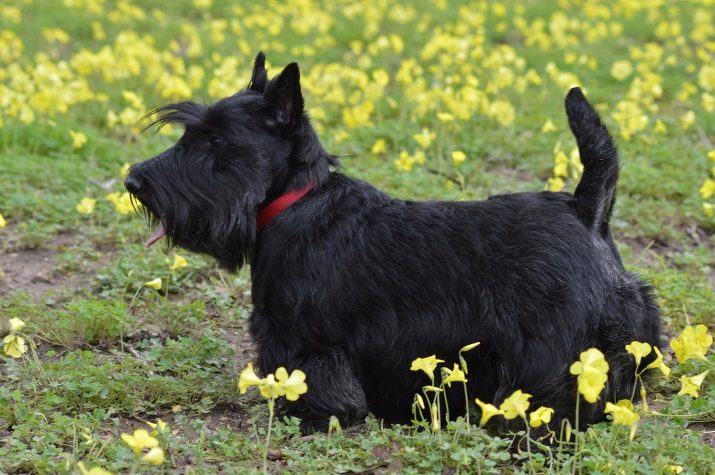
Character
Many people fall in love with the adorable Scottish Terrier look as soon as they see it. But, this breed is characterized by a variable character, which is in no way combined with a charming appearance. Until recently, a cheerful dog who enjoyed playing with its owner can transform into an animal exuding irritation and anger.
Pathological stubbornness is another feature of this breed., and it can complicate the relationship between the pet and its owner. To get the dog to be compliant, the owner must show the puppy who is the leader in the house from the first day. The Scottish Terrier is a small dog that possesses great courage, along with self-esteem. You can often face willfulness, which manifests itself in the fact that the pet does what it wants on purpose. Nevertheless, the animal is anxious about the territory entrusted to it and will never let strangers into it.
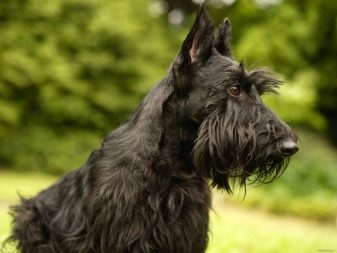
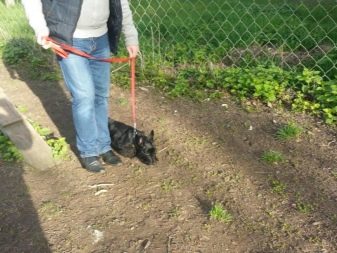
Some individuals can boast of pronounced leader manners and will react aggressively to their relatives. In order for a pet to communicate well with other animals that exist with it under the same roof, you should start with the issue of socialization from puppyhood. Otherwise, you may face the fact that the hunter's instincts will prevail, and the dog will constantly hunt everyone. When walking your pet, you need to consider hunting qualities, due to which the scotch tape can rush in pursuit of another beast.
The Scottish Terrier is a sensitive dog. She is able to determine the mood of her owner only by the intonation of her voice. If the animal does not consider its owner a leader, it will constantly piss him off. Another characteristic trait of these dogs is loyalty and vigilance. For this reason, Scotch tapes are considered good watchmen. In addition, the dog prefers only one person or two with whom he will interact closely. With strangers, the dog behaves wary and detached. He will not caress them.
Scotch tape is characterized by increased playfulness. The dog will play with the ball with great pleasure, arrange races on home territory or on the street.

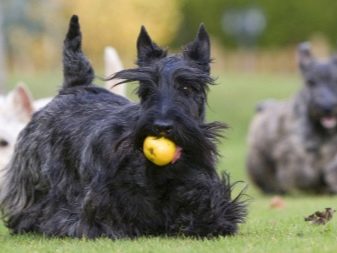
Advantages and disadvantages
The Scottish Terrier is a special dog that differs from its counterparts not only in appearance, but also in character. Before choosing a four-footed friend, you should familiarize yourself with the positive and negative traits of the animal in order to make sure of the correctness of your purchase.
Let's take a look at the most obvious advantages of the Scots.
- Miniature dimensions and decorative characteristics. Due to its small size, the animal can live in an apartment, it does not require a lot of space.
- Unpretentious care. Such a dog does not need complicated care. He only needs a haircut, since the wool does not shed on its own.
- Resistance to all kinds of diseases... The Scottish Terrier rarely gets sick and boasts good health.
- Independence... You can leave the dog alone: it is famous for its natural self-sufficiency, so it will not get bored during the absence of the owner.
- A lively mind and quick wits. These dogs quickly understand what's what, and grasp new skills on the fly.
- Devotion. Breeders say that if you find an approach to your pet, he will become a faithful friend until the last day.
- Sociability. The animal loves human society and is always ready to be there, while it will not be very intrusive.
- Love for walks... The dog is not against long festivities, and they are vital to him.
- Activity and energy.
- Pleasant appearance... The Scottish Terrier always attracts the attention of people on the street.
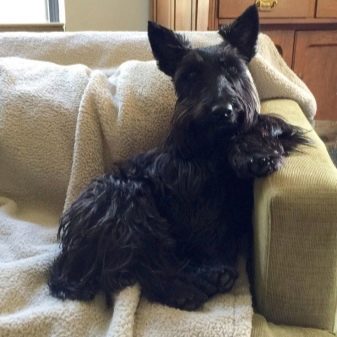

However, the breed also has negative traits.
- Pride and stubbornness. A dog can go for a principle and insist on his own. In order for the animal to be obedient, you should engage in the process of education from the first day, and always insist on your own.
- The terrier does not get along very well with other pets. The dog will be constantly jealous of its owner.
- The coat should be monitored when trimming.
- The dog will bark often and shrilly.
- The breed is only suitable for an experienced owner.
- Walking is required twice a day, along with physical activity and jogging.
- The animal is not suitable for those who lead a sedentary lifestyle.

Life span
If you provide these dogs with proper care, they live quite a long time - 13-14 years. The Scottish Terrier is a genetically healthy dog that is distinguished by its endurance. Activity is in their blood, and they retain it until venerable age. However, the breed has some serious diseases that can be hereditary.
- Scotty cramp This is a neuromuscular disease that manifests itself when the animal is in an agitated state. At this moment, he may have convulsions, loss of consciousness is not observed. This disease is not progressive, so the dog will live normally with it. The number of seizures is individual.
- VWD and hemophilia. Disease of the hematopoietic system. It manifests itself in the form of bleeding associated with a blood clotting disorder. If the disease is severe, bleeding may be spontaneous and begin in internal organs, muscle tissue, or joints. Due to an incurable disease, many scotch tapes died at a young or even puppy age.
- Cushing's Syndrome. It is a disease of the endocrine system. It manifests itself in the excessively produced cortisol. You should contact your veterinarian if the Scotch Terrier is losing weight, experiencing increased thirst, frequent urination, darkening of the skin, and hair loss. Treatment is expensive and lengthy. If you neglect therapy, the dog can die.
- Also the Scottish Terrier can suffer diseases of the skeleton, dysplasia, stenosis of the pulmonary artery, retinal atrophy.
Most diseases can be detected with a genetic test, so you can find out about them before buying a puppy.
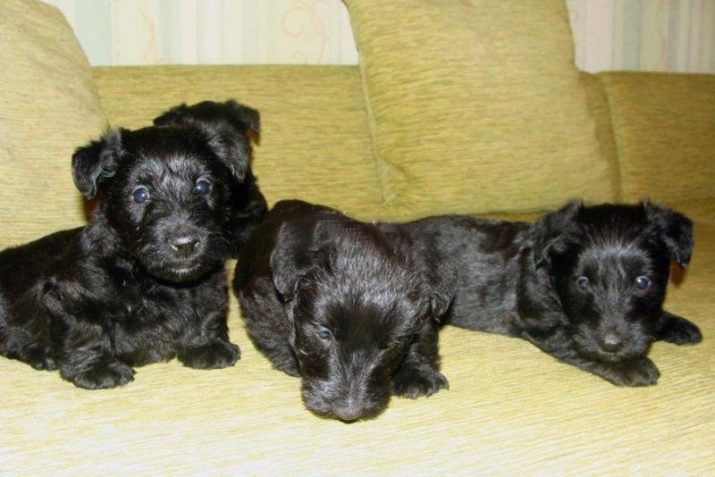
How to choose a puppy?
A puppy who is 8 weeks old is quite difficult to check for compliance with the standard. Breed traits of Scotch Terriers acquire only 5-6 months. Therefore, in order not to be faced with the purchase of a non-purebred or non-standard pet, it is recommended to contact only trusted nurseries. Each mating must be scheduled and registered with the club.
Owners who are afraid to buy a "defective" dog can find a breeder who sells grown puppies. Among the six-month-olds it will be possible to see how promising the dog is for an exhibition career. However, the cost of such a dog will be much higher compared to two month old puppies.
When choosing, you need to know that the head of a small Scottish terrier will look too massive in relation to the general appearance of the animal. This is a normal situation. But if an eight-week-old dog looks fully formed, and is similar in its features to an adult, this suggests that in the future the pet will have a lightweight skeleton with a short skull.
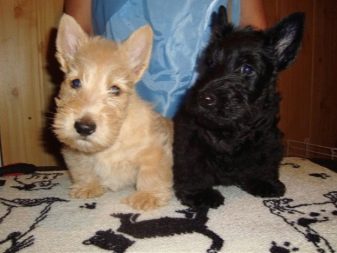

The puppy you like should be checked for health. To do this, you need to examine his ears, the area under the tail. Both areas must be clean. Redness is not allowed in the groin area and under the armpits.
It is important to evaluate the temperament of the future pet while he is with his brothers and sisters.A shy and slow dog is not an option.
If the puppy is too shaggy, and its skull is overgrown with wool, the purchase should be abandoned. In the future, this Scotch Terrier will be soft-coated, which is considered a serious defect. It is recommended to choose puppies with a smooth coat.
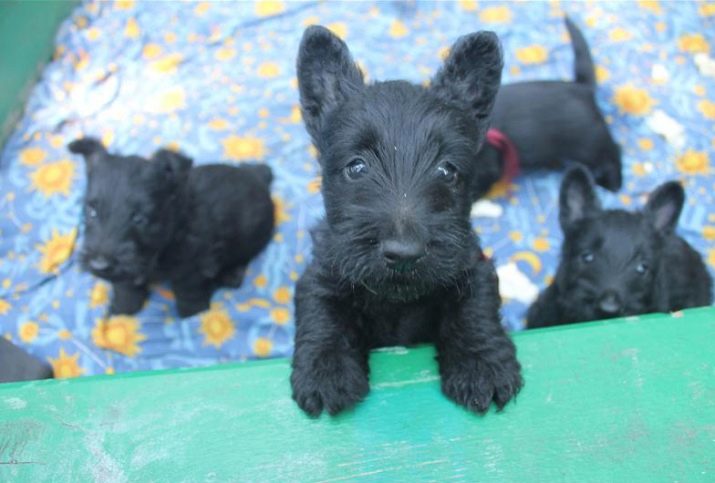
Maintenance and care
The Scottish Terrier can be kept in a small apartment if provided with long walks and physical activity. The dog must run. When the baby is brought into the house, it must be placed next to the owner, since the pet needs close communication with the person. Also, such an arrangement will allow the puppy to quickly understand who is his mentor and friend. The sleeping place should be equipped with wooden bumpers, up to 10 cm high. When installing, make sure that the bed is raised a few centimeters above the floor surface. This maneuver will help keep your pet free from draft.
Toys are a prerequisite for keeping a dog. With their help, you can distract the pet's attention from furniture and other objects in those moments when the dog is left alone. Some owners replace their usual toys with an apple or cabbage stump.
The floor surface should be covered with rugs or newspapers. On the bare floor, the puppy's legs will move apart and this can lead to improper positioning of the limbs or to injuries. You should only walk your pet on a leash until the skeleton of the dog is formed. Then you can use a harness. A muzzle is a must-have accessory; a pet should be taught to it from childhood.
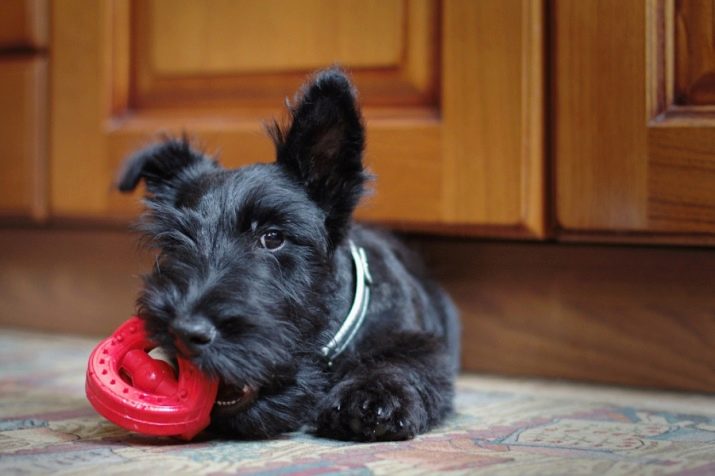
The Scotch Terrier is not suitable for a person who spends most of his life on the couch. For the first six months of life, he will need to walk every two hours. Next year, the dog is walked 4 times a day. When your pet turns 1.5 years old, you can teach him to walk twice a day. The duration of one walk should be at least two hours. If you don't want to walk your four-legged friend for so long, you can resort to walking three times a day, where the walks will last one hour.
From time to time, the dog needs to be bathed, in summer this should happen more often than in winter. In autumn, special clothing should be worn to keep the terrier from getting dirty. Bathing should be done in warm water, with the use of specialized shampoos designed for coarse coats.
"Doggy" Scotch Terrier almost never smells. Therefore, with such a symptom, attention should be paid to the nutrition of the animal: the diet should be balanced, without allergens.

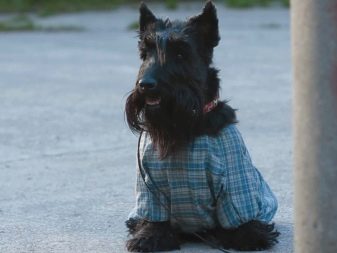
You will have to take care of your ears only occasionally.... The breed is characterized by small open ears, so it is not afraid of otitis media. The teeth of the Scotch Terrier are strong and healthy. Their condition is at the mark "excellent" to a ripe old age. Claws need to be trimmed regularly, even if the pet is constantly under stress. Special attention should be paid to the terrier's beard. It should be wiped clean after every meal and water intake.
Better to immediately buy flat bowls with an autodrinker, designed specifically for bearded breeds... Eyebrows, eyelashes and eyes are areas to watch out for. Since the coat is harsh, it can irritate the mucous membrane of the eye, leading to disease.
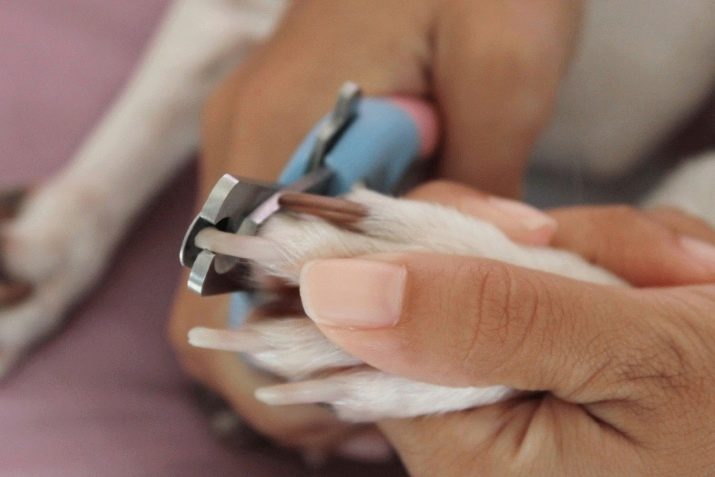
Haircut subtleties
The coat of the Scotch Terrier requiresso that he is provided with constant trimming and haircuts. These are the only conditions that must be observed when keeping dogs. They do not need constant combing, so in order to trim your pet, you will need to find a good master (for exhibitions this is a prerequisite) or master the skill with your own hands.
The Scottish Terrier has a hard coat that protects the dog well from heat and cold, but without mechanical action it does not shed.Therefore, old hairs that have lost their elasticity and shine should be plucked out by hand. Trimming should be done 2-4 times a year.
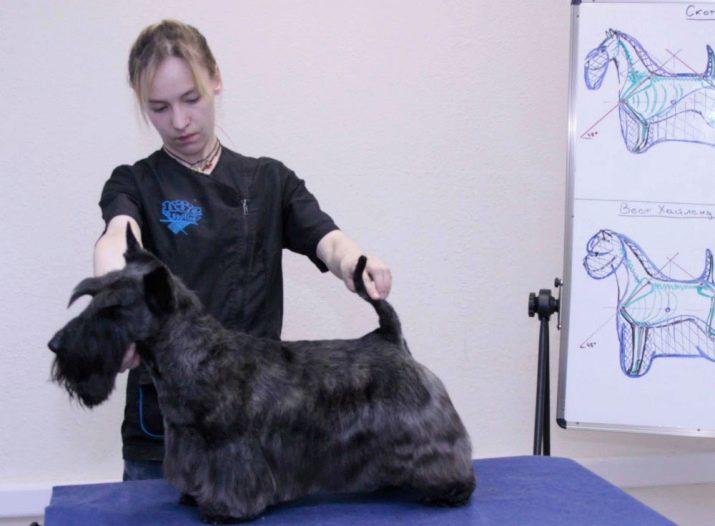
The home haircut scheme has the following nuances.
- Hair covering the head, cheeks, neck and throat should be shortened with a clipper or scissors. Be sure to leave the dog with its eyebrows and beard, thanks to which the animal has a focused look. It is necessary to check that the length of the hair does not interfere with the dog's vision.
- On the back of the nose, hairs should be removed shortly, thus obtaining a parting. The ears are trimmed in a similar manner, while maintaining the pointed tips.
- To give a neat look, the fur on the sides, back and under the tail is also shortened. On the shoulders, the hairs are removed from the sides.
- The "skirt" should be located on the stomach, body and legs. The length can be different: from a few centimeters to the length of the floor.
This is a homemade Scotch Terrier trimming option. Many details are provided for the exhibition, which include requirements for the thickness and length of the coat. Therefore, such dogs will need grooming, which will be carried out by a professional.
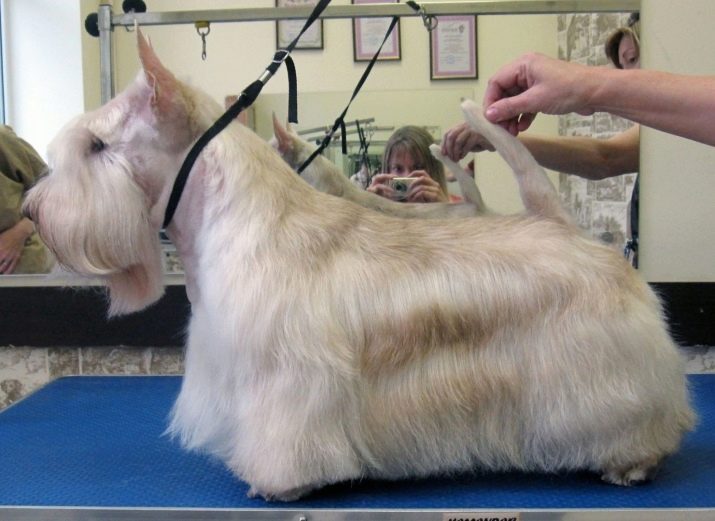
What to feed?
There are two categories of owners: connoisseurs of prepared food and fans of natural food. If the owner plans to use ready-made dry food, you need to choose only from a high quality and balanced line. Premium, super premium will do. The composition should be low in protein.
Since the Scottish Terrier has a good appetite, the owner of the dog should monitor the amount of food consumed by his pet. You cannot feed the dog from the table.

If the owner wants to feed the dog with natural food, the following rules should be kept in mind.
- Do not give your dog fatty and unhealthy food. The liver is the weakness of scotch tape, so it's best not to risk it.
- Raw food is a priority, since protein is released during heat treatment.
- It is forbidden to give dyes, flavor enhancers and preservatives.
- Meat - this is the basis of the diet. You should feed your pet with beef with cartilage or chicken. The meat is cut into small pieces and served raw. It is undesirable to feed a four-legged friend with minced meat.
- You can give your dog vegetables and cereals. From cereals, it is allowed to feed with buckwheat, rice, oatmeal. You can add vegetable oil with finely chopped herbs.
- Fermented milk products can be given. Do not feed with milk.
- Boiled eggs, dried fruits, raw sea fish (fillets) - also a permissible list of the diet.
- You can systematically feed on large bones that do not have sharp edges. You can also buy special bones available at the pet store.

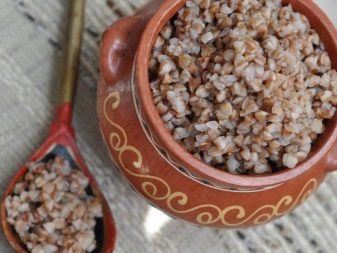
Upbringing
The Scottish Terrier is an intelligent but stubborn dog that does not tolerate criticism. She is very sensitive about praise and flattery. These character traits should be known to every Scotch Terrier owner who has decided to start the educational process.
At the very beginning of training, the Scottish Terrier is able to learn with pleasure, but as soon as the classes become familiar to him, without a novelty, he will immediately lose interest in them. Selectivity is another character trait that dog handlers do not like. The Scottish Terrier is able to perfectly execute commands that he likes, but ignore those that he is not interested in. You can build interest with treats and petting. Other options do not work.
At the moment, no special training program has been developed for such a breed. However, dog breeders believe that the classical technique is not suitable for scotch tapes. You can try to combine games with learning, shortening the lesson itself as much as possible.
Scotch tape is not a dog that will work through fatigue and boredom. For this reason, group classes are not suitable for such animals, since they last for a long time, and the Scotch Terrier quickly gets tired of this.
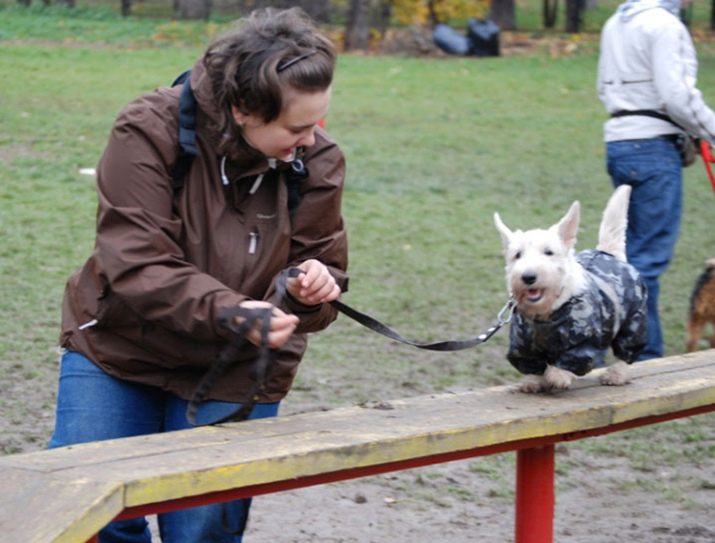
To cope with the hunter's instinct, because of which you will have to constantly run after the dog during walks, you need to immediately accustom him to a leash. A well-bred dog will bring less trouble to its owner. Every owner should also know that the Scotch Terrier is an incredibly active dog and nothing can be done about it.
You can only distract the pet's attention with toys from other items, but you should hide expensive shoes. Expensive repairs do not need to be done until the dog becomes an adult. If the puppy becomes too impudent, it can be punished with light slaps. It is allowed to apply such punishment only at the time of misconduct, so that the terrier understands what he is being punished for.
Puppies love to bite, which should be stopped right away, since in adulthood the animal will continue to show aggression. Shouting to influence the dog will not work. This technique can work with other breeds, but with a Scotsman, such training can only lead to frustration or resentment. Do not expect that the pet will immediately begin to understand the command; first, he must decide on the purpose of its implementation. You do not need to load the dog with constant repetitions of the learned skills. It will only tire him.
Training should be done from the first day of a puppy's life in a new home. This is a prerequisite for obtaining an obedient pet, because this breed was bred for independent work, where dependence on humans is not required. Due to this, the Scotch Terrier can be particularly stubborn when training. If the owner of the dog does not have enough time and energy to work with the terrier, you can turn to a specialized school for help.
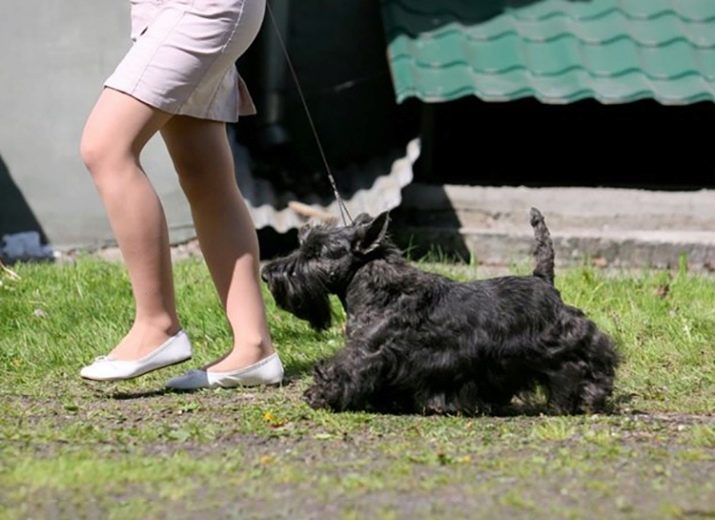
Nowadays, the Scotch Terrier is rarely used as a hunter. This is not due to a decrease in hunting instincts, but to the reluctance of the owners to train their pet in this area. Dog breeders are more interested in the external data of terriers, therefore they do not allow the dog to swarm in the ground.
If the owner wants to remind his dog of the chasing skills, it is enough to visit the baiting zones of his region, where the Scotch Terrier will quickly remember his origin. After a couple of months of training, he will be a highly skilled fox catcher, and will be able to conquer even the deepest holes.
In such training, the dog will get rid of excess energy. He will do what he loves, getting the physical activity that he needs. However, the owner of the dog must be extremely careful during the walk: if the owners usually try to extinguish the hunter's instincts, this will not work here. In ordinary life, the dog will also pursue its goals in the form of cats and small dogs.
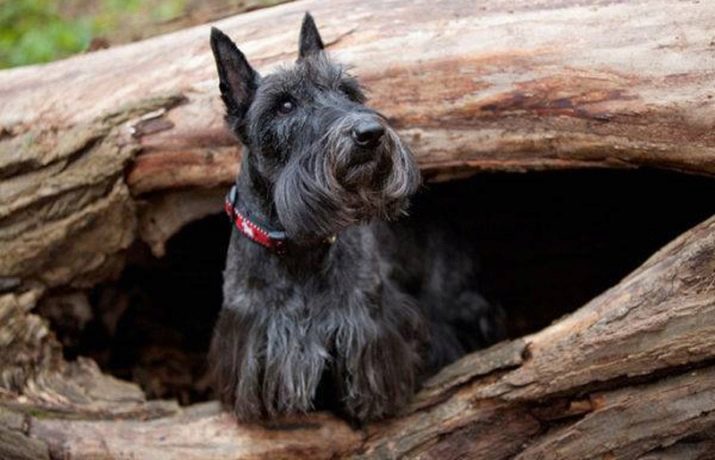
Owner reviews
Reviews of Scottish Terriers may be controversial, but negative comments are often related to the owner's inability to handle the dog. Studying the reviews of the owners, you can find out more about the features of the breed and decide whether it is suitable for a certain person or you should pay attention to other four-legged pets.
Many people talk about the exceptional loyalty of their pet, who is always ready to be there without becoming intrusive. He can just be near the person while he is doing business. Many owners note that the Scottish Terrier does well with older people. The dog appreciates peace and quiet, and will be a faithful companion for them.
The tough, hypoallergenic coat is another reason for the owners' delight. Scotch tape does not require special care, it does not need to be combed out, it has healthy teeth from birth.
The only condition for leaving is systematic haircuts, which will require additional funds. However, many owners of non-show dogs have learned to cut their dogs with their own hands.
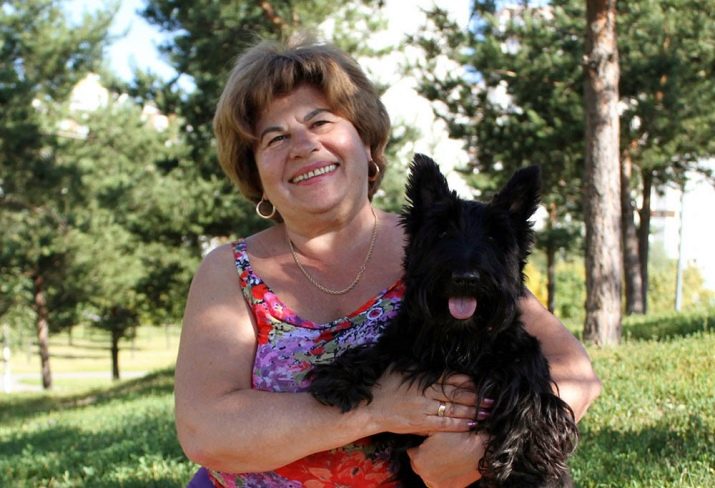
Stubbornness and independence are characteristic features of the Scotch Terrier. He does not like coercion, and if the owner forces the dog to follow the commands by force, it will fundamentally refuse to obey. This issue is solved with the help of early education. You can find an approach to any pet and earn its respect by proving yourself to be the leader of the pack.
The dog does not like finding other animals in the house. The Scottish Terrier is very jealous and can be aggressive. It is necessary to suppress all manifestations of negativity even in puppyhood, so that there are no problems in the future. Increased barking is another breed flaw that some people complain about. The dog may bark too often, but it still does not compare with the amount of noise that other small dog breeds make. Besides, the problem of barking can also be solved by proper upbringing.
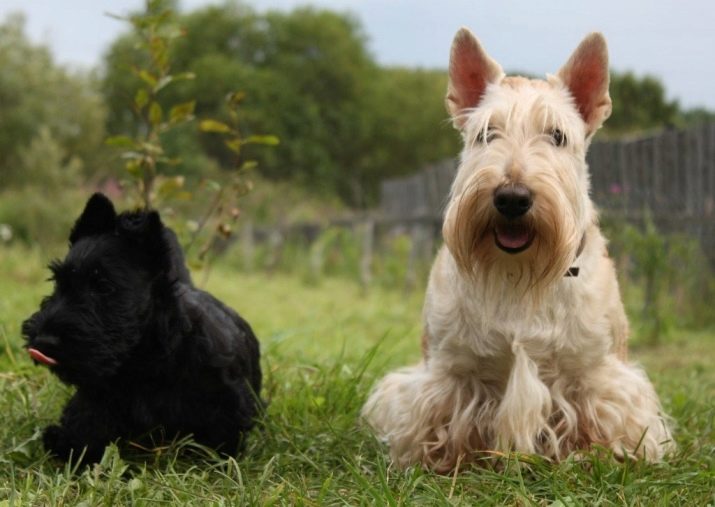
For more on the characteristics of the breed, see the next video.






































